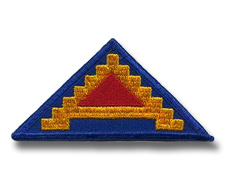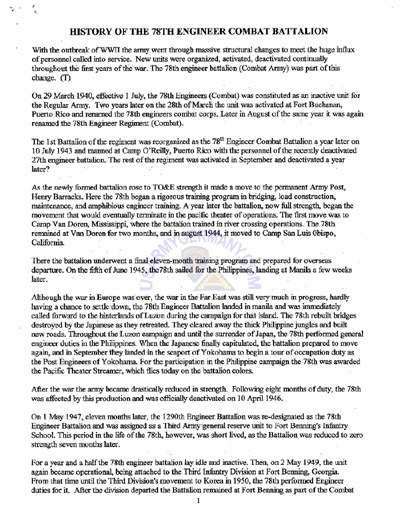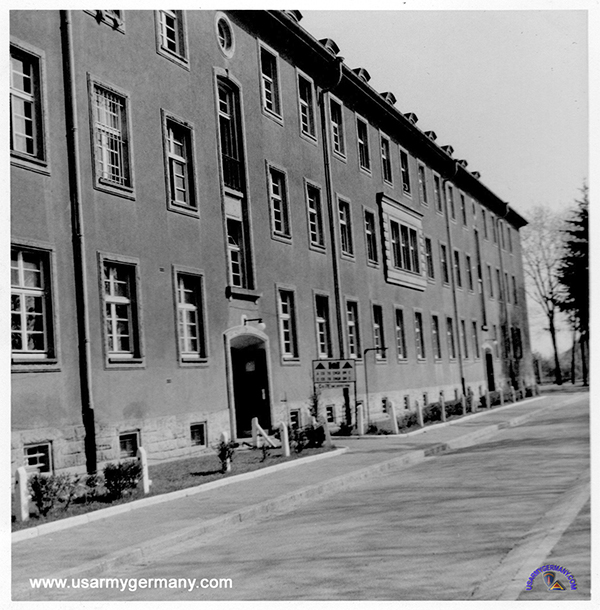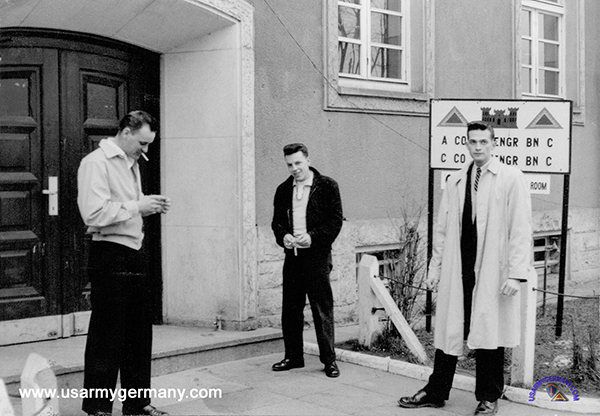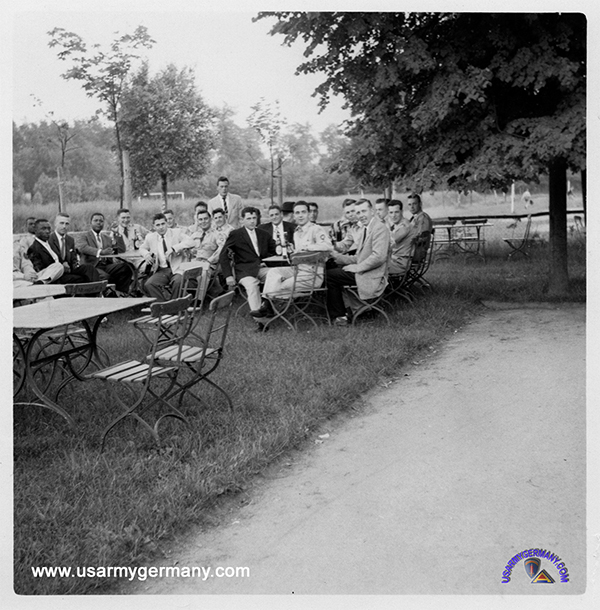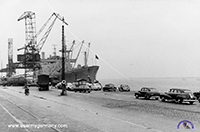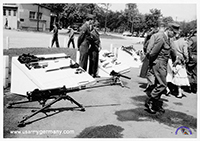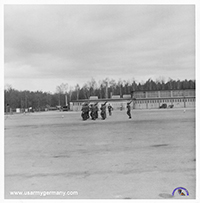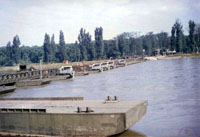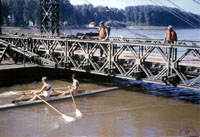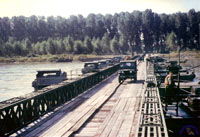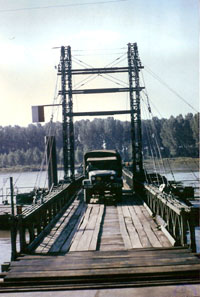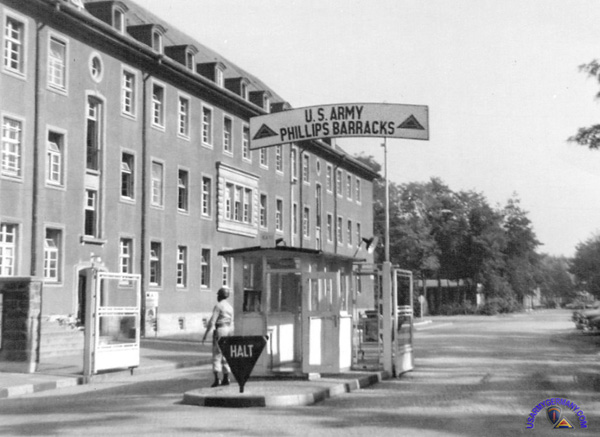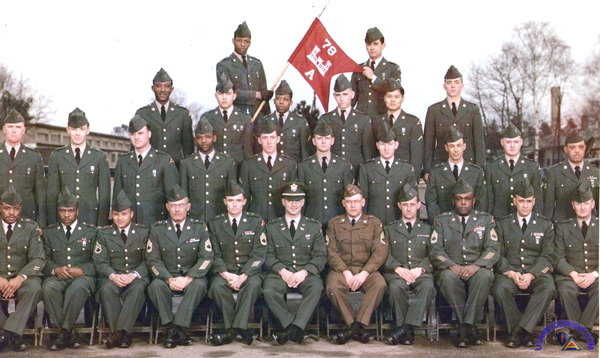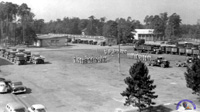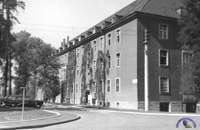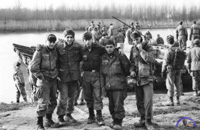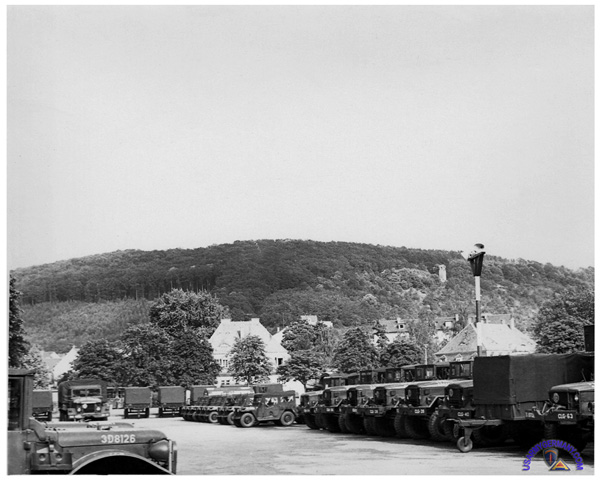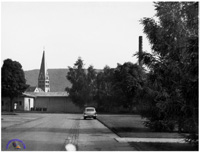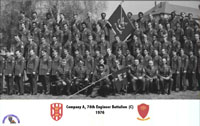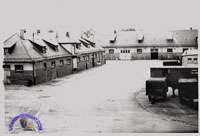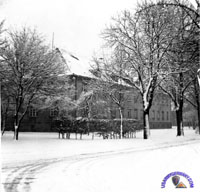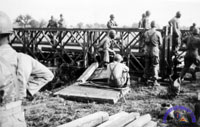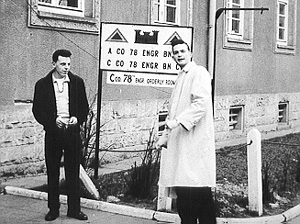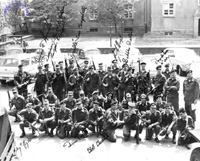| If you do
NOT see the Table of Contents frame to the left of this page, then
Click here to open 'USArmyGermany' frameset |
|||||||||||||||||
|
78th
Engineer Battalion |
|||||||||||||||||
|
|
|||||||||||||||||
|
|||||||||||||||||
|
|
|||||||||||||||||
| 78th Engineer (Combat) Battalion History | |||||||||||||||||
| Phillips Barracks, Karlsruhe | |||||||||||||||||
| 1957 - 1991 | |||||||||||||||||
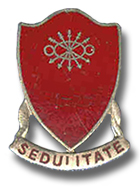 78th Engineer Bn DUI
78th Engineer Bn DUI |
|||||||||||||||||
(Source: Submitted by the Historian, US Army Engineer School via Ms. Bianka Adams, Ph.D., Office of History, USACE, Alexandria, Va.) |
|||||||||||||||||
|
(Source:
Adjutant, HQ 78th Engr Bn (C), 1989)
|
|||||||||||||||||
|
HISTORY
OF THE 78TH ENGINEER BATTALION
The 78th Engineer Battalion (Combat) was originally organized at Fort Buchanan, Puerto Rico on 29 March 1940 and activated two years later. In mid 1944, the Battalion started a series of moves from Fort Buchanan to Mississippi, to California, and finally, in June 1945, to the jungles of Luzon, Phillipines where they built roads and bridges throughout the islands. After World War II, the Battalion served 8 months as post engineers at Yokohama, Japan, after which they were inactivated. It was awarded the Pacific Streamer for its participation in World War II. In May 1949, the 78th Engineer Battalion was reactivated at Fort Benning, Georgia. During the eight years at Fort Benning, the 78th assisted the local community in disaster relief and provided engineer support and instruction to the Infantry School. In early 1957, the 78th moved to Karlsruhe, West Germany (Phillips Barracks) under "Operation Gyroscope" and became part of the 555th Engineer Group. In December 1964, the 78th moved to its present location at Rheinland Kaserne, Ettlingen, West Germany, when the 555th Engineer Group was inactivated. The Battalion motto is "Sedulitate", which means, "By Diligence". Currently, the 78th Engineer Battalion supports the 1st Armored Division. We provide mobility, countermobility, and survivability support to the Division's 1st and 3rd Brigades. The 78th mechanized in 1988 and will be the test battalion for the Corps of Engineer's "E" Force concept. The 78th and 16th Engineers will combine to form an engineer brigade as part of the 1st Armored Division. In the very near future, we will cease to be part of the 7th Engineer Brigade and sew on the patches of "Old Ironsides". Another exciting aspect of the 78th Engineer Battalion is our role in the Allied Command Europe Mobile Force (AMF). Company C provides the entire engineer contingent for the AMF and deploys twice a year to the flanks of NATO -- Norway, Denmark, Turkey, Greece, or Italy. The purpose of the AMF is to demonstrate NATO's resolve to defend Western Europe should anyone attempt to invade the minimally defended flanks of NATO. The soldiers thoroughly enjoy their AMF role and the opportunity to travel and make friends with the soldiers of our NATO allies. Our partnership relationships with the French, Canadians, and Germans is also flourishing. We currently have partnerships with 2nd Regiment du Genie in Metz, France; the 11th Regiment du Genie in Rastatt, West Germany; the 4th Canadian Regiment in Lahr, West Germany and the local Germany reserve unit here in the Karlsruhe area. We have had numerous cultural and training exchanges with each of our partnership units. |
|||||||||||||||||
| If you have more
information on the history or organization of the 78th Engr Bn, please
contact me |
|||||||||||||||||
|
|
|||||||||||||||||
| 1957 | |||||||||||||||||
| (Source: Email from Jerry Coombs, son of Donald Coombs who was assigned to the 78th Engr Bn, 1957-58) | |||||||||||||||||
| PFC Donald E. Coombs served with First Platoon, "A" Company, 78th Engineer (C) Battalion at Ft. Benning and then deployed with the Bn to Germany, as a GYROSCOPE replacement for the 499th Engr (C) Bn. The battalion sailed from Brooklyn Army Terminal on the USNS GEIGER in early February and arrived at Phillips Barracks in Karsrule on February 14, 1957. In June 1958, Donald returned to the States. |
|||||||||||||||||
|
|||||||||||||||||
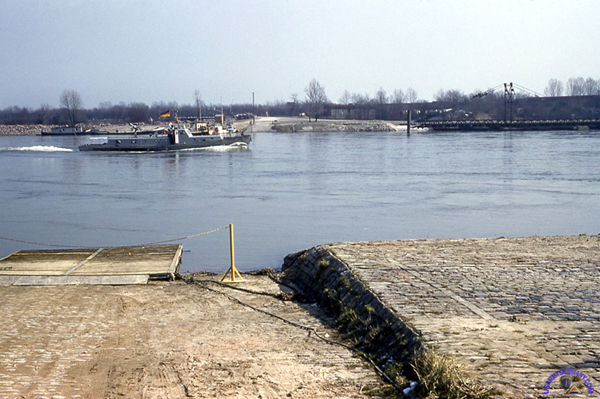 A swing bridge and German patrol craft (ex-US Navy PR24) on the Rhine River, late 1950s. (Can anyone identify the location?) |
|||||||||||||||||
| Swing Bridges (Source: Email from Gary Shirley, Co B, 78th Engr Bn) |
|||||||||||||||||
|
I was the last U. S. Bridge Officer for the Rheinhausen Swing Bridge located between Rheinhausen and Speyer. I became Bridge Officer in February 1957 as a Platoon Leader in Company B of the 78th Combat Engineer Bn. We were stationed at Phillips Barracks in Karlsruhe.
|
|||||||||||||||||
|
|||||||||||||||||
| In December 1958 I turned the bridge over to a German Army Officer. I saw the bridge again in 1966 and 1993 and as mentioned on this site it no longer exists. I am kind of the "Reunion Officer" for the 78th Engineer Bn. so I am in contact with all of the officers I mentioned except for LTC Norman L. Hall and his unnamed replacement who lost the pontoon. They are both deceased. We have had two all Bn. reunions for the fellows who were in the unit 1957 - 1960. I am planning on another reunion in 2008 but it will only be for former officers. I have e-mail addresses for 19 former officers from the 78th that I served with including all of the former Bridge Officers. I think that is pretty good as we are all over 70 now. ADDITIONAL INFORMATION The bridge squads did live on site. I am not sure what I can tell you about the barracks and mess hall at Rheinhausen. I think that they were two fairly small separate buildings built on pilings and joined by a deck in front. The sleeping quarters I think was just one large room. There were usually about 7 to 8 fellows from my platoon stationed there including the Bridge Sgt. and a couple of cooks. The Bridge Sgt lived with his family over in Rheinhausen. In addition there were maybe 3 or 4 fellows from the Labor Service. They may have had their own room in the barracks, I can't remember for sure. A couple of my men may have been there for nearly the entire two years but we did occasionally rotate fellows back to Phillips Barracks in Karlsruhe. As I mentioned before, I went up to the Bridge site weekly, some times driving my own car and sometime going up in a helicopter. |
|||||||||||||||||
| (Source: Email from Jack Conlin, 78th Engr Bn) | |||||||||||||||||
| 78th Engineer
Battalion CAMPAIGN PARTICIPATION CREDIT WORLD WAR II ( Asiatic-Pacific Theater without inscription) Source = 130th Engr.Brg.mil/history |
|||||||||||||||||
| 1959 | |||||||||||||||||
| (Source: Email from Vincent Romeo) | |||||||||||||||||
| I was assigned to the 78th Combat Engineer Battalion in Karlsruhe Germany from August 1959 - December 1960. I just saw your web-site and I was wondering if you had a list of the members of my unit and where they are. ADDITIONAL INFORMATION If the Communists poured across the border, millions of civilians would have to be evacuated further West. Stationed at Phillips Barracks were the 78th Combat Engineer Battalion and (now I'm not totally sure about the number) the 502nd Floating Bridge Company. Our "First" and "Primary" mission was to build the Pontoon Bridge across whatever part of the Rhine we were told to span. The evacuation of millions of civilians would have clogged the roads and the river crossings were key to a hopefully successful mission. The floating bridge companies only delivered the bridges. They didn't have the manpower to assemble them. We also could build "Bailey" and "Heavy Timber" bridges. Once that was done we were to become an Infantry outfit. Along the Czech border, East of "Graf" (Grafenwoehr) we were up in the hills with M-1's, .30 caliber machine guns, a few BAR's, a few .50's, and that was about it, for "A" Company. The Armored units near us were further North around Mannheim. We had a Special Forces camp North of us also. I'll have to be honest: I was 18 years old at the time and I wasn't concentrating too hard about who was where. The Artillery units: 8"ers were with us at Graf. Four or Five guys in civilian clothes were the "Real Guys" with the responsibility of Detonating the weapon. We had all the Ammo we could carry with orders to shoot to kill anyone who approached us we didn't know. That never happened. We were so isolated that anyone approaching us had to up to no good. The ADM Weapons, (I think), would have been very successful there. Further North along the border with East Germany the terrain was much flatter, and probably would have been the area the communist forces would have taken. When I was in Germany - August 1959 to December 1960 - I never heard the term: "The Fulda Gap". We knew the Northern Areas would probably get the full force of an attack, but we were sure they would try to come across the Czech border too. When I was on the Troop Ship coming home, around Dec.28th. there was an American Soldier in the Brig. He opened fire on the commies who were having a mock attack on the border. He opened fire with a .30 cal. Machine Gun. The commies were all in their tanks so no one got hurt. |
|||||||||||||||||
|
|||||||||||||||||
| 1963 | |||||||||||||||||
| (Source: Email from Mike Gabhart, 78th Engr Bn, 1963-65) | |||||||||||||||||
| Hello, I came across your site and was interested as I was sent to the 78th Combat Engineer Bn and stationed there at Karlsruhe, Ger. from 1963 until summer of 1965 and the whole time I was there we were quartered at Phillips Barracks, not counting the time spent out in the field at Graf. It's been a long time ago, but I do know that the 78 was still located at Phillips Barracks when I left in the Summer of 1965. I noticed in the account that it was stated that in December of 1964 the 78th moved to its present location at Rheinland Kaserne, Ettligen West Germany when the 555 was inactivated. That may have happened, but I know it had to be later that the summer of 1965. Probably no one cares at this point in time, but just to set the record strait I felt I should at least let you know what I remember, before it fades! It was a great post, small with an EM Club and Snack bar, also the Mess Hall, and a make shift movie house and I seem to remember some bingo nights some where on the base, I know I won a carton of cigarettes there, and sometimes there were dances with local girls attending, they also showed silent pictures of war abuses by the Germans after the Bingo game. At the time I am not sure if I liked it so well, but looking back that long ago, I had a lot of great times and wish I could re-live them now! I do remember what my base pay was when I joined the Army in 1962......$78.00 per month!! and after passing all the inspections on the way to the pay line and donating to all the different tables it didn't take long to spend what you had left down town, but you could get a really good meal at the EM Club for not a lot of money. Anyway, thought I would contact you and let you know what I remember, I left Phillips Barracks in the summer of 1965 not Ettlingen! |
|||||||||||||||||
| 1964 | |||||||||||||||||
| (Source: Email from Rudolf R. Boentgen, 78th Engr Bn, 1964-66) | |||||||||||||||||
| My first assignment as a newly minted LT, was with the 78th Engr Bn (C), then stationed at a barracks north of Karlsruhe, Germany in 1964. Shortly thereafter we move to a station south of Karlsruhe (at Ettlingen) named Rheinland Kasserne. The 78th also included an ADM (Atomic Demoltion Munnitions) platoon. Before leaving Germany, I was reassigned to the HHC of the 555 Engr Gp (C) as the S-4 officer, taking the place of a Major, Captain, and four (4) Warrant Officers My tour in Germany started in the 78th Engr Bn (C) at the Phillips Barracks in Karlsuhe as a Platoon Leader. My first company commander was Capt. Mulchary. (He later became a Major General on Schwartzkopf's staff in Dessert Storm.) The battalion then moved to the Rheinland Kaserne in Ettlingen which was about 5 miles south of Karlsruhe.
We trained in some local areas but the bigger operations were in Grafenwoehr where there was a central firing range for artillery and the tankers. One of my assignments at Grafenwoehr was to dispose of some old explosive (leaking dynamite, crumbling det cord, old TNT and cratering charges). We set electric and non-electric rings for two holes, each filled with more than 100 pounds of the old stuff and "retired to a safe distance". We set of the electric detonators. One boom, not the two expected. We set of the non-electric circuit. Nothing. We wait the 30 minutes for a non-electric misfire. Then my sergeant and I walked down the road to investigate, he carrying blasting caps and I carrying two pound stick of TNT. During the walk I was imagining the note home from the Army: "Dear Mrs Boentgen, We regret to inform you. . . .". But, to my relief, as it turned out the two charges had both gone absolutely simultaneously and so we hear only one blast. I was never as scared in my whole life. We had an ADM platoon in the Battalion and I went to the Army school for forward assembly operations on ADMs. But I was never actually assigned to the platoon. My final assignment was to the 555 Group Headquarters as S-4. I took the place of a Major, Captain, and four Warrant Officers. In retrospect, this may have been because they knew that the Group was going to be coming home in a few years. I was personally signed for the four aircraft of the Aviation Platoon. Then I was reassigned to Fort Benning as an engineer instructor. That was in November 1966 |
|||||||||||||||||
| 1965 | |||||||||||||||||
| (Source: Email from Dick Tatina, HHC, 78th Engr Bn, 1965-66) | |||||||||||||||||
HC 78th Eng BN June 1965 - June 1966 |
|||||||||||||||||
|
|||||||||||||||||
| (Source: Email from Bob Anglea) | |||||||||||||||||
| I am a veteran of the 78th Engr. C. Bn. which served in Germany from about 1957 to 1991 when the unit was inactivated. In 1997, a group of us old guys from the unit when it was stationed at Ft. Benning, Georgia in the Korean period, got together and started having reunions. In recent years, veterans that served with the unit in Germany have joined us in our bi-annual reunions. We are planning a 2008 Reunion. I have many pictures of the 78th's activities from it's service in Puerto Rico in the early 1940s to it's inactivation in 1991. We would be glad to share these pictures and events with you if you like. We also have pictures of the Karlsruhe and Rhineland Kaserne, Etlingen period that we would be glad to share with you. |
|||||||||||||||||
|
|||||||||||||||||
|
|||||||||||||||||
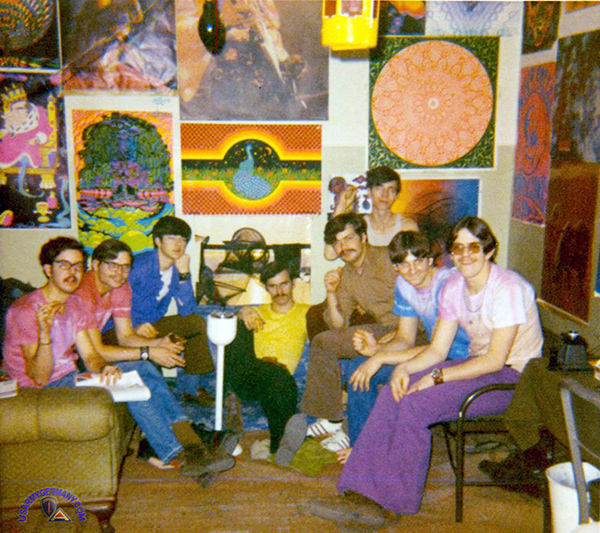 Room 215 at the ZOO (Jack Kilpatrick) (From L to R: Alan Hoyt, Patrick Brannon, Ron Brown, Gary Ridgeway, Jack Crook, Bob Rosano, Jack Kilpatrick and Dennis Graziano) |
|||||||||||||||||
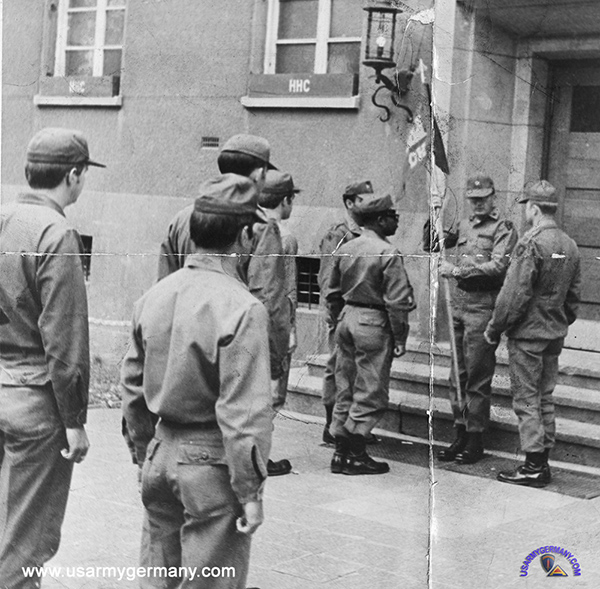 Battalion formation with Colonel Burke in front of Headquarters Company building, 1971 (Jack Kilpatrick) |
|||||||||||||||||
| 1971 | |||||||||||||||||
| (Source: Email from Jack Kilpatrick) | |||||||||||||||||
| I was a PFC stationed at the 78th Combat Engineering Battalion, 7th Brigade, Ettlingen, Germany at the Rheinland ("ZOO") Kaserne.
I was assigned to Headquarters Company "COMMO" from 1971-1973. This is a picture of "The ROOM 215" with some of the GI Brothers that hung with us. The room was on the 2nd Floor of HHC. 215 was a 2-man Room that was known to bring all kinds of Open Minded Rheinland (ZOO) Kaserne GI’s from HQ and other Companies together. My room mate, E-1 Bob Rosano, was also assigned to HQ “COMMO”! We loved Ettlingen, the Germans and we had a good time and a lot of fun while serving our country in the US Army in Germany (Europe). In 1912, when the Ettlingen Castle passed into the possession of the city of Ettlingen by purchase, the commune undertook to build a Sergeant Barracks with Officer’s Food Service in the area north of Huttenkreuzstraße. The complex was built by the city of Ettlingen in the years 1912-1914. Due to the First World War, the building was a Reserve Hospital until 1920. During the Weimar Republic, the buildings were used by authorities and for residential purposes. In 1936, the facility was handed over to the Military Administration. Until the end of the Second World War, the area housed an Army NCO School of the 5th Infantry Regiment. Since December 1999, the Fraunhofer Institute for Optronics, System Technology and Image Analysis has been located in the listed building. |
|||||||||||||||||
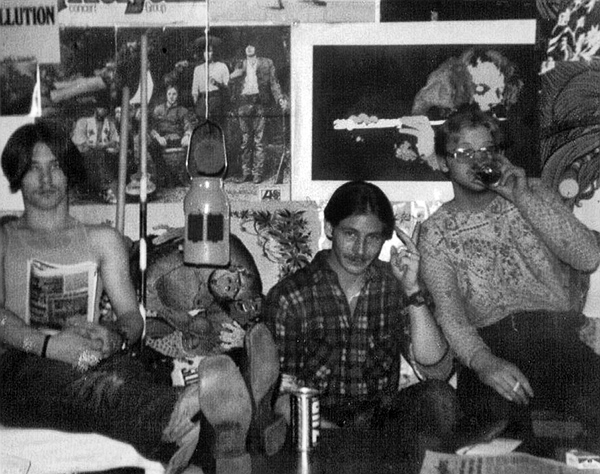 Lou's room at Gerszewski Barracks, around 1973 |
|||||||||||||||||
| 1972 | |||||||||||||||||
| (Source: Email from Louis Gillespie) | |||||||||||||||||
| I can not tell you how much pleasure it was to come across this website. I was stationed at the Rheinland Kaserne, Ettligen Germany from 11/1972 – 11/1974, B CO, 3rd Platoon, 3rd Squad.
Being stationed there had a lasting impact on my life and will be with me forever. Thinking back to those times and places makes me want to go back but “The Zoo” is no longer. The world was a much different place back then. The people and friends you met there are forever etched into memories. To those who have experienced this place before and after me understand what a unique place this was. The stories and places you were lucky to see, downtown Karlsruhe anytime was a blast. The parties at the Piccadilly bar were incredible, the Pyramid, the park it was all good. Outside the post was the Fritz, shot many a game of pool there. Looking at the pictures of the bridges, heavy equipment was something, I had forgotten what the motor pool looked like but it all came rushing back as soon as I saw it. Damn, I had great times there. Please continue to keep this site going. It brings great pleasure to those of us served there. To those Brave Men and Women who currently serve our country, we will be forever in your debt for your service, to those have served “JOB WELL DONE “We served our country in a troubled time as those are today. Walk proud and with dignity, our country remains free because of veterans like us. To those who have other ideas “Don’t Tread On Me! |
|||||||||||||||||
|
|
|||||||||||||||||
| ADM Platoon | |||||||||||||||||
| 1968 | |||||||||||||||||
| (Source: Email from Ed Hosier, ADM Pltn, 1968-69) | |||||||||||||||||
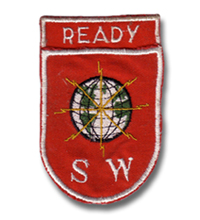 ADM Platoon Patch ("READY" Tab was added after successful completion of a TPI ) ADM Platoon Patch ("READY" Tab was added after successful completion of a TPI ) |
|||||||||||||||||
REUNION 2008 Date and Place TBD John Shaughnessy and John Baxter are compiling a contact list in preparation for a reunion in 2008. To be included, please contact John Baxter: John L. Baxter 4107 Brown Meadow Katy, Texas 77449 Home phone: 281-859-1887 email: baxter-jl@usa.net |
|||||||||||||||||
| (Source: Email from Ed Hosier, ADM Pltn, 1968-69) | |||||||||||||||||
|
|||||||||||||||||
| (Source: Email from John J. Shaughnessy, ADM Pltn) | |||||||||||||||||
| Happened upon your website... got a bit of a surprise to find MY picture posted... in with that group in the ADM shot. It was a hoot to see that one... If you only knew!... That group was so "spit and polish"... MANY, including myself, often "broke starch" twice a day! That shot was QUITE unique... as we were all "out of uniform" so as to be distinguished on the exercise as "Aggressors"... and we were having a little bit of fun with it as well.
Thanks for posting it... FYI - I happened to find your site by searching on the "78th Engineers" as I recall... prompted by a message from another "ADM guy" I served with in the 78th; John Baxter. John told me that he was trying to put a 78th ADM reunion together for next year (2008) sometime. That would make it a 40th for those of us who served with John. I gather that he had reached me through my profile on Military.com. From al I can gather... That pic that Ed Hosier posted has just about everybody in it that John would want to invite to a reunion so it was quite a treat to find it. I'm more than a bit surprised to discover that I'd forgotten many of those characters... and many names still escape me. I knew them ALL so well at one time. As to telling you about ADM... That presents a bit of a quandary for me... I'm not sure what you'd like to know... and not sure what might still be classified. I noticed that one fella on your site, Gordon Colbeck, addressed that fact that we trained on two weapons systems. As much of this information is out on the web now... I'll share those links with you. I understand that at least one of the systems we trained with... The SADM "Small Atomic Demolition Munition", has been declassified. The SADM was designed to be backpacked and to be capable of being "Jumped In". The small weapons ALWAYS gave me pause... BECAUSE, If *I* could carry it somewhere, by myself... so could someone else! Here they say "Special" Atomic Demolition Munition... But... that's NOT what our TM said. "Special" may have been an earlier designation. Here's another site with some good information... and some references and a link RE: the "Davey Crockett" system etc. The Davey Crockett was NOT one of the systems that we trained with: This site has pics and a good deal of data... Frankly, there is information here that I would not have been comfortable sharing personally... i.e., about yields etc. I cannot confirm the data posted on this site: Here is a site with some links to a couple of video clips RE: the SADM. The video quality is poor but the narration is adequate. These videos address a maritime deployment of the munitions and are not necessarily directly related to the training that the Army Engineers undertook with respect to deployment of this munition. As you no doubt know, much of the reconstruction of Germany under the Marshall Plan was done with an eye toward tactical and strategic defense planning... such that some dams, bridges and like infrastructure were chambered, or otherwise designed so as to be able to be destroyed quickly and efficiently so as to deny ground to any potential Soviet advance. The tactical nuclear weapons, such as ADMs and those "small" "tactical" weapons designed for deployment on short-range missiles or via artillery were all essentially "ground denying" weapons. From my independent reading on the matter, the best estimates were that it all would have bought us a week at BEST in the face of a full Soviet heavy armor advance. We regularly trained with, and were supported by other NATO forces... and that's about all I'm comfortable saying about that. We had 6 ADM teams in our Platoon... Training was daily, exact, and pretty intense. We not only memorized the Technical Manual associated with each weapons system... we did the same with many DOA, DOD, DOE, USAREUR, and NATO policies. I imagine that it's common knowledge now... but when the Russian tanks drove into Prague in 1968, we were on "High Alert"... some Teams at the storage facilities... codes in hand. The codes NEVER left the safe at the Kaserne... which itself was under 2-man armed guard 24/7... except under those circumstances. Given this "personal" perspective on the mater I have always understood that that event in Prague was EVERY bit as "close" as Kennedy's "October Standoff" with Khrushchev over the missiles in Cuba years earlier! In that photo that Ed Hosier posted... I'm the guy in the middle with the "Bush Hat" on. I was 19-20 at the time... I turned 20 that summer (1968)... and I was second in command of my Team at that time. My Team Chief was SSgt Canda... the Hawaiian fella two down to my right in that photo... A heck of a good guy... and a 2nd degree Black Belt as I recall). A sobering thought when looking at that photo... and considering the ages of those fellows... The individuals in that photo were the individuals who actually had their finger on the actual "button" at that time. Each and every one of those characters in that photo had the authority to sign for, and detonate a weapon... subject to the release of the codes... and "The Two Man Rule." I think that should satisfy most of your "casual" questions... If I tell ya anything else... I'll have to kill ya... :-) Thanks again, Walter, Great Site... Nice job! |
|||||||||||||||||
| (Source: Email from Gordon Colbeck, ADM Pltn, 1969) | |||||||||||||||||
In 1969 I was with the ADM (Special Weapons) Platoon, 78th Engr Bn stationed at Rheinland Kaserne, Ettlingen, Germany. A NATO secret security clearance was required. We helped fight the "Cold War".
From time-to-time, the news stories stateside would say that NATO troops were maneuvering close to (or near) the East/West border. We were mobile and often responded to alerts on short or no notice. Let me tell you that a military convoy "upset" some (many) drivers on the famous autobahns.
Our Platoon, on a daily training basis, would practice fusing two devices. Each one a different size. We would train in the basement of the barracks passing through armed security. As a fail safe, each device was fused three seperate ways. Of course we trained on simulators. The actual munitions were kept at a seperate depot facility.
Hope this helps you. I really enjoy your website and if I think of anything else to add I'll let you know. |
|||||||||||||||||
| (Source: Email from Fary W. Hanlon, ADM Pltn, 1970-72) | |||||||||||||||||
| It was with a great surprise that I saw your web page this evening on the 576th Engr. Co. that served in Germany during the past century. I have looked for years for some information on ADM, and information on men who may have served in the early 1970's at Rhineland Kaserne in Ettlingen, Germany, in the ADM Platoon. My name is Gary Hanlon and I live in Framingham Ma. I proudly served this country from June 1970-1972. First at Fort Leonard Wood, then Belvoir in Virginia, then Rhineland Kaserne in Ettlingen...and yes I spent several weeks in Oberammergau in the summer of 1971 taking the ADM refresher course. I look back on that time as time well spent. And I reminisce about the men I served with, and hope some day to connect with a few. To date I have contacted only one... a good friend who currently lives in Michigan. If you have any information on the ADM Unit who served at "Rhineland" during 1970-1972; or have any info on the following individuals ... Harry O. (Bo) Marshall, Roberto (Pancho) Gonzales I would sincerely appreciate you passing it along. Harry Marshall was from Pittsburgh, and Roberto Gonzales from San Diego. It is difficult talking to people who were never in ADM...because they don't really understand what we did...and inevitably I have to say to them..."I can't really tell you...or I'd have to kill you" That's what we used to say at Rhineland. Of course with a slight grin on our faces. My oldest boy 2nd Lt. John Edward Hanlon is with the 62nd Combat Engineer Batallion (Combat Heavy) currently stationed at Fort Hood Texas. He is 23 years old and also has been through Fort Leonard Wood...so he and I commiserate about the Engineers a lot. He asks me a lot of questions about ADM, and I have told him that I believe 12E20 is no longer. Do you know whether or not that is true? In closing I will say that I sincerely enjoined your web page, and would appreciate any info that you might have. |
|||||||||||||||||
| Related
Links: 78th Combat Engineers website - a reunion website for anyone who served with the 78th Engineer Combat Battalion. Next reunion is in Chattanooga, TN in 2014 - no exact date has been set yet. |
|||||||||||||||||
